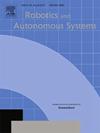Semi-autonomous unmanned aerial manipulator teleoperation for push-and-slide inspection using parallel force/vision control
IF 4.3
2区 计算机科学
Q1 AUTOMATION & CONTROL SYSTEMS
引用次数: 0
Abstract
Performing inspection and maintenance tasks with aerial robots in complex industrial facilities require high levels of maneuverability and dexterity. As full autonomy still struggles to provide robust solutions due to limited adaptability and high development costs, this study explores the paradigm shift towards shared control teleoperation for tilting unmanned aerial manipulators (UAMs). The research initially focuses on integrating onboard camera measurements and interaction force feedback within a parallel force/vision controller for push-and-slide inspection tasks. The control loop lends itself to the development of a semi-autonomous operation architecture that enables a human operator to easily accomplish the task by means of a simple input device. The paper presents a user study evaluating task completion performance with human-in-the-loop control versus fully autonomous execution. Statistical analysis of 20 user experiences provides insights into the levels of autonomy necessary for effective task completion. Among the analyzed control modalities, statistically significant differences arise when the sliding feature is autonomous, denoting it as the most difficult to manually accomplish. The investigation is conducted within a simulated environment to ensure the safety of sensitive instruments and accommodate users with varying levels of expertise. By proposing shared control architectures, this research addresses the challenges of autonomous UAM operations in hazardous industrial environments, highlighting the benefits of human oversight and control in enhancing task efficiency and safety.
基于平行力/视觉控制的半自主无人航空机械臂推滑检测遥操作
在复杂的工业设施中使用空中机器人执行检查和维护任务需要高水平的机动性和灵活性。由于适应性有限和开发成本高,完全自主仍然难以提供强大的解决方案,本研究探讨了向倾斜无人机(UAMs)共享控制远程操作的范式转变。该研究最初的重点是将机载相机测量和相互作用力反馈集成到一个平行力/视觉控制器中,用于推动和滑动检测任务。控制回路有助于开发半自主操作体系结构,使人工操作员能够通过简单的输入设备轻松完成任务。本文提出了一项用户研究,评估了人在环控制与完全自主执行的任务完成性能。对20个用户体验的统计分析提供了有效完成任务所需的自主水平的见解。在所分析的控制模式中,当滑动特征是自主的时,会出现统计学上显著的差异,这表明它是最难手动完成的。调查在模拟环境中进行,以确保敏感仪器的安全,并适应具有不同专业知识水平的用户。通过提出共享控制架构,本研究解决了危险工业环境中自主UAM操作的挑战,强调了人类监督和控制在提高任务效率和安全性方面的好处。
本文章由计算机程序翻译,如有差异,请以英文原文为准。
求助全文
约1分钟内获得全文
求助全文
来源期刊

Robotics and Autonomous Systems
工程技术-机器人学
CiteScore
9.00
自引率
7.00%
发文量
164
审稿时长
4.5 months
期刊介绍:
Robotics and Autonomous Systems will carry articles describing fundamental developments in the field of robotics, with special emphasis on autonomous systems. An important goal of this journal is to extend the state of the art in both symbolic and sensory based robot control and learning in the context of autonomous systems.
Robotics and Autonomous Systems will carry articles on the theoretical, computational and experimental aspects of autonomous systems, or modules of such systems.
 求助内容:
求助内容: 应助结果提醒方式:
应助结果提醒方式:


